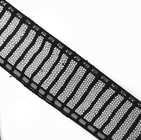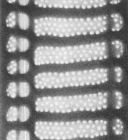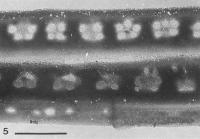HABs taxon details
Pseudo-nitzschia multiseries (Hasle) Hasle, 1995
175738 (urn:lsid:marinespecies.org:taxname:175738)
accepted
Species
Pseudo-nitzschia pungens f. multiseries Hasle, 1993 · unaccepted
marine, terrestrial
recent only
Hasle, G.R. (1965). Nitzschia and Fragilariopsis species studied in the light and electron microscope. II. The group Pseudonitzschia. Skrifter utgitt av Det Norske Videnskaps-Akademi i Oslo, Matematisk-naturvidenskapelig klasse, Ny Ser.,, 18: 45 pp., 17 pls [details]
(of Nitzschia pungens f. multiseries Hasle, 1965) Hasle, G.R. (1974). Validation of the names of some marine planktonic species of Nitzschia (Bacillariophyceae). Taxon, 23(2/3): 425-428
page(s): p. 427 [details]
(of Nitzschia pungens f. multiseries Hasle, 1965) Hasle, G.R. (1965). Nitzschia and Fragilariopsis species studied in the light and electron microscope. II. The group Pseudonitzschia. Skrifter utgitt av Det Norske Videnskaps-Akademi i Oslo, Matematisk-naturvidenskapelig klasse, Ny Ser.,, 18: 45 pp., 17 pls
page(s): p. 14; pl. 2, fig. 1-2, pl. 5, fig. 10-12, pl. 6, fig. 4, pl. 7, fig. 9-11 [details]
(of Nitzschia pungens f. multiseries Hasle, 1965) Hasle, G.R. (1974). Validation of the names of some marine planktonic species of Nitzschia (Bacillariophyceae). Taxon, 23(2/3): 425-428
page(s): p. 427 [details]
(of Nitzschia pungens f. multiseries Hasle, 1965) Hasle, G.R. (1965). Nitzschia and Fragilariopsis species studied in the light and electron microscope. II. The group Pseudonitzschia. Skrifter utgitt av Det Norske Videnskaps-Akademi i Oslo, Matematisk-naturvidenskapelig klasse, Ny Ser.,, 18: 45 pp., 17 pls
page(s): p. 14; pl. 2, fig. 1-2, pl. 5, fig. 10-12, pl. 6, fig. 4, pl. 7, fig. 9-11 [details]
Type locality contained in Oslofjord
type locality contained in Oslofjord [details]
Distribution P. multiseries is globally distributed from subpolar to subtropical waters: In Atlantic waters of Europe, North and South...
Harmful effect P. multiseries produces domoic acid, and was the cause of the major harmful event in Canada 1987 caused by Amnesic...
Identification P. multiseries is morphologically similar to P. pungens, but can be differentiated by having 3-4 rows of poroids (P....
Distribution P. multiseries is globally distributed from subpolar to subtropical waters: In Atlantic waters of Europe, North and South America and in Pacific waters of Northeast Asia and North America i.e. from ca. 65°N-15°N and 30°S -50°S [details]
Harmful effect P. multiseries produces domoic acid, and was the cause of the major harmful event in Canada 1987 caused by Amnesic...
Harmful effect P. multiseries produces domoic acid, and was the cause of the major harmful event in Canada 1987 caused by Amnesic Shellfish Poisoning (ASP), affecting more than 100 persons of which 3-4 died (Bates et al. 1989).
Since this incident, toxin producing strains of P. multiseries has been reported from globally distributed strains e.g. France (Amzil et al. 2001), Japan (Kotaki et al. 1999) and Canada (Evans et al. 2004).
Domoic acid has been found in amounts up to 21 pg/cell in cultured strains (e.g. Bates et al 1989, Douglas & Bates 1992)
[details]
Since this incident, toxin producing strains of P. multiseries has been reported from globally distributed strains e.g. France (Amzil et al. 2001), Japan (Kotaki et al. 1999) and Canada (Evans et al. 2004).
Domoic acid has been found in amounts up to 21 pg/cell in cultured strains (e.g. Bates et al 1989, Douglas & Bates 1992)
[details]
Identification P. multiseries is morphologically similar to P. pungens, but can be differentiated by having 3-4 rows of poroids (P....
Identification P. multiseries is morphologically similar to P. pungens, but can be differentiated by having 3-4 rows of poroids (P. pungens has 2), a poroid density of 5-7 (P. pungens has 2-5), and partly by a higher density of band striae. (Hasle 1995, Hasle et al. 1996). Distinguishing between the two species usually requires electron microscopy or molecular data.
[details]
[details]
Kociolek, J.P.; Blanco, S.; Coste, M.; Ector, L.; Liu, Y.; Karthick, B.; Kulikovskiy, M.; Lundholm, N.; Ludwig, T.; Potapova, M.; Rimet, F.; Sabbe, K.; Sala, S.; Sar, E.; Taylor, J.; Van de Vijver, B.; Wetzel, C.E.; Williams, D.M.; Witkowski, A.; Witkowski, J. (2024). DiatomBase. Pseudo-nitzschia multiseries (Hasle) Hasle, 1995. Accessed through: Lundholm, N.; Churro, C.; Escalera, L.; Fraga, S.; Hoppenrath, M.; Iwataki, M.; Larsen, J.; Mertens, K.; Moestrup, Ø.; Murray, S.; Tillmann, U.; Zingone, A. (Eds) (2009 onwards) IOC-UNESCO Taxonomic Reference List of Harmful Micro Algae at: https://www.marinespecies.org/hab/aphia.php?p=taxdetails&id=175738 on 2024-11-14
Lundholm, N.; Churro, C.; Escalera, L.; Fraga, S.; Hoppenrath, M.; Iwataki, M.; Larsen, J.; Mertens, K.; Moestrup, Ø.; Murray, S.; Tillmann, U.; Zingone, A. (Eds) (2009 onwards). IOC-UNESCO Taxonomic Reference List of Harmful Micro Algae. Pseudo-nitzschia multiseries (Hasle) Hasle, 1995. Accessed at: https://www.marinespecies.org/hab/aphia.php?p=taxdetails&id=175738 on 2024-11-14
Date
action
by
original description
Hasle, G.R. (1965). Nitzschia and Fragilariopsis species studied in the light and electron microscope. II. The group Pseudonitzschia. Skrifter utgitt av Det Norske Videnskaps-Akademi i Oslo, Matematisk-naturvidenskapelig klasse, Ny Ser.,, 18: 45 pp., 17 pls [details]
original description (of Nitzschia pungens f. multiseries Hasle, 1965) Hasle, G.R. (1974). Validation of the names of some marine planktonic species of Nitzschia (Bacillariophyceae). Taxon, 23(2/3): 425-428
page(s): p. 427 [details]
original description (of Nitzschia pungens f. multiseries Hasle, 1965) Hasle, G.R. (1965). Nitzschia and Fragilariopsis species studied in the light and electron microscope. II. The group Pseudonitzschia. Skrifter utgitt av Det Norske Videnskaps-Akademi i Oslo, Matematisk-naturvidenskapelig klasse, Ny Ser.,, 18: 45 pp., 17 pls
page(s): p. 14; pl. 2, fig. 1-2, pl. 5, fig. 10-12, pl. 6, fig. 4, pl. 7, fig. 9-11 [details]
additional source Liu, J.Y. [Ruiyu] (ed.). (2008). Checklist of marine biota of China seas. <em>China Science Press.</em> 1267 pp. (look up in IMIS) [details] Available for editors
status source Hasle, G. R. (1995). <i>Pseudo-nitzschia pungens</i> and <i>P. multiseries</i> (Bacillariophyceae): nomenclatural history, morphology and distribution. <em>J. Phycol.</em> 31: 428-435.
note: The taxon is raised to species level [details]
subsequent type designation Hasle, G. R. (1974). Validation of the names of some marine planktonic species of <i>Nitzschia</i> (Bacillariophyceae). <em>Taxon.</em> 23: 425., available online at https://doi.org/10.2307/1218752
note: Here the type of P. multiseries is designated [details]
original description (of Nitzschia pungens f. multiseries Hasle, 1965) Hasle, G.R. (1974). Validation of the names of some marine planktonic species of Nitzschia (Bacillariophyceae). Taxon, 23(2/3): 425-428
page(s): p. 427 [details]
original description (of Nitzschia pungens f. multiseries Hasle, 1965) Hasle, G.R. (1965). Nitzschia and Fragilariopsis species studied in the light and electron microscope. II. The group Pseudonitzschia. Skrifter utgitt av Det Norske Videnskaps-Akademi i Oslo, Matematisk-naturvidenskapelig klasse, Ny Ser.,, 18: 45 pp., 17 pls
page(s): p. 14; pl. 2, fig. 1-2, pl. 5, fig. 10-12, pl. 6, fig. 4, pl. 7, fig. 9-11 [details]
additional source Liu, J.Y. [Ruiyu] (ed.). (2008). Checklist of marine biota of China seas. <em>China Science Press.</em> 1267 pp. (look up in IMIS) [details] Available for editors
status source Hasle, G. R. (1995). <i>Pseudo-nitzschia pungens</i> and <i>P. multiseries</i> (Bacillariophyceae): nomenclatural history, morphology and distribution. <em>J. Phycol.</em> 31: 428-435.
note: The taxon is raised to species level [details]
subsequent type designation Hasle, G. R. (1974). Validation of the names of some marine planktonic species of <i>Nitzschia</i> (Bacillariophyceae). <em>Taxon.</em> 23: 425., available online at https://doi.org/10.2307/1218752
note: Here the type of P. multiseries is designated [details]
 Present
Present  Inaccurate
Inaccurate  Introduced: alien
Introduced: alien  Containing type locality
Containing type locality
From regional or thematic species database
Classification In phylogenetic analyses, P. multiseries clusters together with P. pungens as sister taxon; firmly within a larger cluster of Pseudo-nitzschia species (e.g. Lundholm et al 2002) [details]Distribution P. multiseries is globally distributed from subpolar to subtropical waters: In Atlantic waters of Europe, North and South America and in Pacific waters of Northeast Asia and North America i.e. from ca. 65°N-15°N and 30°S -50°S [details]
Harmful effect P. multiseries produces domoic acid, and was the cause of the major harmful event in Canada 1987 caused by Amnesic Shellfish Poisoning (ASP), affecting more than 100 persons of which 3-4 died (Bates et al. 1989).
Since this incident, toxin producing strains of P. multiseries has been reported from globally distributed strains e.g. France (Amzil et al. 2001), Japan (Kotaki et al. 1999) and Canada (Evans et al. 2004).
Domoic acid has been found in amounts up to 21 pg/cell in cultured strains (e.g. Bates et al 1989, Douglas & Bates 1992)
[details]
Identification P. multiseries is morphologically similar to P. pungens, but can be differentiated by having 3-4 rows of poroids (P. pungens has 2), a poroid density of 5-7 (P. pungens has 2-5), and partly by a higher density of band striae. (Hasle 1995, Hasle et al. 1996). Distinguishing between the two species usually requires electron microscopy or molecular data.
[details]
Morphology Cells lanceolate in valve view, lanceolate-linear in girdle view, sharply pointed ends
Valve width 3.4-4.5µm
Valve face with 10-15 striae and fibulae in 10 µm.
No central nodule (and interspace)
Each stria with 3-4 rows of poroids, each with 5-7 poroids in 1µm
Striated bands, valvocopula with 19-30 striae in 10µm
[details]
Reproduction Sexual reproduction of P. multiseries has been described by Davidovich & Bates (1998) [details]
Genbank link to ITS rDNA sequence for morphologically verified strain of P. multiseries
Genbank link to regions D1-D3 of LSU rDNA of morphologically verified strain of P. multiseries
To Barcode of Life
To European Nucleotide Archive, ENA (Pseudo-nitzschia multiseries)
To GenBank (3920 nucleotides; 562 proteins)
To PESI (from synonym Pseudo-nitzschia pungens f. multiseries Hasle, 1993)
To ITIS
Genbank link to regions D1-D3 of LSU rDNA of morphologically verified strain of P. multiseries
To Barcode of Life
To European Nucleotide Archive, ENA (Pseudo-nitzschia multiseries)
To GenBank (3920 nucleotides; 562 proteins)
To PESI (from synonym Pseudo-nitzschia pungens f. multiseries Hasle, 1993)
To ITIS







